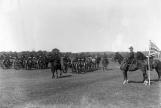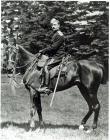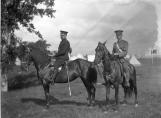2
Reviewing OfficerCirca 1903
Sussex, New Brunswick, Canada
 Credits:
Credits:New Brunswick Provincial Archives - P13-160 / Woodstock Battery of Artillery passing in review before Col. Vidal
Annual Report, Department of Militia and Defence of the Dominion of Canada
Militia General Orders
3
Merrit Cup Challenge1930
Sussex, New Brunswick, Canada
 Credits:
Credits:Association of the 8th Canadian Hussars (Princess Louise's) Inc
Crook and Marteinson; 125 Years of Service, The Pictorial History of the 8th Canadian Hussars (Princess Louise's)
Ganong, AT, A Historical Outline of the Regiment
4
Mounted TrooperCirca1903
Sussex, New Brunswick, Canada
 Credits:
Credits:Gary Bowser
Annual Report, Department of Militia and Defence of the Dominion of Canada
5
Mounted Officer, LCol Wedderburn1901-1914
Sussex, New Brunswick, Canada
 Credits:
Credits:Association of the 8th Canadian Hussars (PL) Inc
Annual Report, Department of Militia and Defence of the Dominion of Canada
6
The Cavalry ChargeCirca 1908
Sussex, New Brunswick, Canada
 Credits:
Credits:Gary Bowser
Annual Report, Department of Militia and Defence of the Dominion of Canada
Regimental Orders, 8th Princess Louises Hussars (1907-1911)
7
The Guns Roll PastCirca 1903
Sussex, New Brunswick, Canada
 Credits:
Credits:New Brunswick Provincial Archives - P13-153 / Artillery in the field
Annual Report, Department of Militia and Defence of the Dominion of Canada
8
Mounted Artillery OfficersCirca 1903
Sussex, New Brunswick, Canada
 Credits:
Credits:New Brunswick Provincial Archives - P32-64 / Military scene - two soldiers mounted on horses
Annual Report, Department of Militia and Defence of the Dominion of Canada
Militia General Orders
9
Until the automobile and related motor powered equipment was introduced in the military, the horse was one of the most important assets a soldier had at his disposal and great care was taken to ensure the horses were fit and ready for service.It was not conceivable to even consider establishing units in the province that relied heavily on horses until 1825 when the first cavalry units were commissioned due to the lack of available horses. However the cavalry were not the only unit that relied on horses. They were needed to pull the guns, transport supplies, drag the bridge timbers and provide ready transport to members of all arms when necessary including the infantry who traditionally fought on foot.
The horse was such a valuable commodity that many records indicate they were treated and paid more than a soldier. For example the Militia Orders of Canada in 1880 set the allocation for daily rations of a man at 13 cents per day while a horse received 24 cents per day. The Hussar history relates cases in later years where the soldier came to camp and was paid one dollar per day and the horse that he rode was rented for two dollars per day. By 1902, the rates for daily rations had only increased to 33 cents for horses and 25 cents for men. The Hussar history goes on to tell us that some horses were so well trained that they would react to drill faster than the fledgling soldiers who was riding them. Soldiers often came to camp every second or third year but the horse was there each summer and thus became better adapted.
Many inspection reports in Militia Orders provide detailed evaluation on the state of the unit's horses and its equipment. Often the Regiments and Battalions would provide funding for the construction of their own stables because no government funding was available for such items. In 1900 it was decided to eliminate the use of stables for the horses, which resulted in numerous complaints and loss of some horses. In the annual militia report to Parliament that year, the report on Camp Sussex was very negative in respect to the treatment of the horses and the lack of stables. The report goes on to say that the men of the Regiments even offered to rent space for their horses as part of their pay for attending camp to help alleviate the problem and pay for new stables. As a direct quote from the Militia report "It only disgusts the men and renders the service unpopular". Another concerned voiced in Parliament was that it might impact the ability for the camp to rent horses from local farmers for training if they felt the animals were not being treated correctly. Needless to say the report for 1901 states new stables have been erected and have satisfactorily solved the problem.
As the lessons of war were being learned first hand in south Africa during the early stages of the Boer War they quickly were adapted during training at the camp. Surprisingly enough the ability to mount and dismount easily and readily and to ease the horses by dismounting when ever possible was one of the first lessons brought back.
In the Militia Orders of 1903, Guidance was issued on how to make claims for injuries during training and the same procedure was applied to officers, men and their horses. This included loss of work and /or period of disability.
A letter dated 10 July 1907 was sent to the Camp Commander requesting an investigation into the illness of the horse of Private Dixon as it fell ill at camp and its condition has worsen since leaving camp on 05 July 07.
The Routine Orders of the 8th Hussars dated 08 June 1908 details the requirement of the Veterinary Officer to inspect all horses and details what is required. The following paragraph simply states "The inspection by the Regimental MO will be done on the men immediately following the veterinary inspection of the horses". Numerous mentions in Militia Orders and their annual reports indicate concerns over the lack of adequate medical supplies for the horses and that veterinary kits had become depleted. The loss of a horse would immediately prompt an investigation and the necessary corrective action.
The use of railways to transport horses, which started in 1874, was approached very cautiously and was conducted only after the commanding officers overruled the concerns of the soldiers. These concerns were valid as a number of horses were lost over the years in train accidents. This concern was also voiced in Parliament during the Militia Report of 1902 which directed the need for the Federal Government to look into the treatment of horses by the railway during transport, particularly in shunting activities when horses were receiving concussions at alarming numbers.
Not withstanding all of the above the horse continued to be the very essence of the militia for many more years to come.
